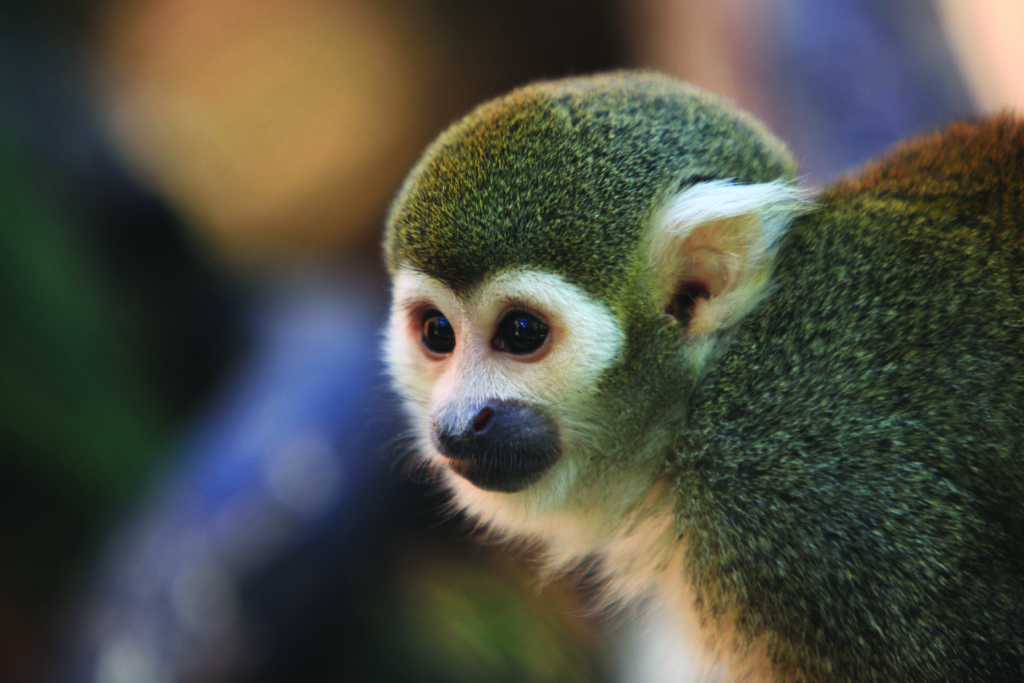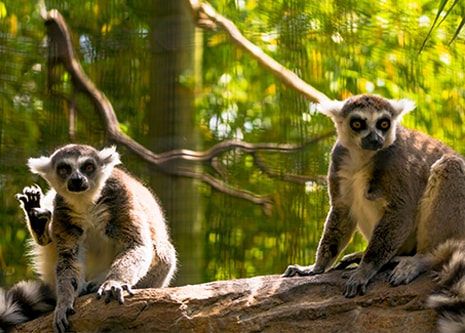
- VisitSupport Happy HollowDONATE TODAYExploreSupport Happy HollowDONATE TODAYLearnSupport Happy HollowDONATE TODAYSupport
-
Today's Hours: 10:00 am to 5:00 pm
Zoo in the HollowCommon Squirrel Monkey

Scientific Name: Saimiri sciureus
Family: Cebidae
Order: Primata
Class: Mammalia
Range: South America
Habitat: Subtropical and Tropical Forest
Lifespan: 15-20 yearsWhat do they look like?
Squirrel monkeys have thick fur ranging in color from olive to grey on the body and reddish to yellow on the back and limbs. They have white patches of fur on the chest, neck and face. Their muzzle is hairless, showing black skin around the lips and nostrils. Their bodies are around 12 inches long and their tails around 15 inches. They have 5 clawed digits on each hand and foot, with pseudo-opposable thumbs for climbing and grasping. Their large close-set eyes give them good binocular vision.
How do they behave?
Squirrel monkeys live in large troops, often split up into subgroups of juveniles, adult males and adult females with young. Squirrel monkeys are very vocal, using screams, peeps, barks and purrs to communicate. They are arboreal (tree dwelling), and they utilize their long tails to help them maintain their balance while climbing through the forest canopy. Squirrel monkeys are diurnal (active during the day), however to conserve energy they will often rest during the hottest part of the day. Common squirrel monkeys have been observed “urine washing,” spreading urine over their hands, feet, and fur. This helps spread their scent throughout their territory, allows others in their troop to follow their trail, improves their grip on branches, and can help cool their body through evaporation. Although they are territorial and will defend their home range from other squirrel monkey troops, squirrel monkeys sometimes work together with other monkey species, both to help find food resources and to avoid predators.
What’s on the menu?
In the wild, these omnivorous monkeys eat fruit, flowers, insects and small vertebrates. At the Zoo they eat fruit, vegetables, and primate biscuits.
How are they born?
Male squirrel monkeys compete for mates by gaining excess weight, called “fatting.” Females then choose the largest male in their troop to breed with. Squirrel monkeys are born between June and August after a gestation period of 150-170 days. Juveniles tightly cling to their mother’s back during travel and for protection. They will stay with their mother for up to one year and reach sexually maturity at two and a half to three years of age.
Conservation Connection
There are currently 5 different species of squirrel monkey and their conservation status ranges from Least Concern (Saimiri sciureus) to Vulnerable (Saimiri ustus) according to the International Union for Conservation of Nature (IUCN). One of the main threats to these monkeys is habitat loss and the pet trade. One organization focusing on primate conservation is the American Society of Primatologists (ASP). This organization works to fund research and education initiatives directed towards primate conservation. If you would like to help squirrel monkeys you can start by educating your friends about them. In most states, it is illegal to privately own primates. You can encourage your friends to choose a domestic animal as a pet instead of an exotic species. Domestic species include animals such as dogs and cats. Exotic species include animals such as parrots and monkeys. Instead of getting a monkey as a pet, tell your friends to check out their local humane society, where they will find people who can help them make the proper pet choice!

Zoo on the Hill
Located across from the Keep-Around Carousel is the Zoo on the Hill. Learn about wildlife up close during daily meet-and-greets, leap like a lemur on the playground, brush and feed the goats,, or take a peek inside Doc’s Critter Care building and the Ranch House. Double-H Ranch features a combination of animal exhibits, including giant anteaters and red ruffed lemurs, as well chickens and domesticated animals that are docile enough to touch.
See Animals
Education Ambassadors
From camps and classes to scout badges and sleepovers, Happy Hollow education programs have something for everyone! The zoo education program offers a broad range of hands-on, engaging programs and public presentations featuring education ambassador animals. These encounters are designed to connect you to wildlife and the conservation of their habitats around the world.
See AnimalsVisit Us Today
Plan an unforgettable experience at San Jose’s family-friendly park and zoo.
Learn More